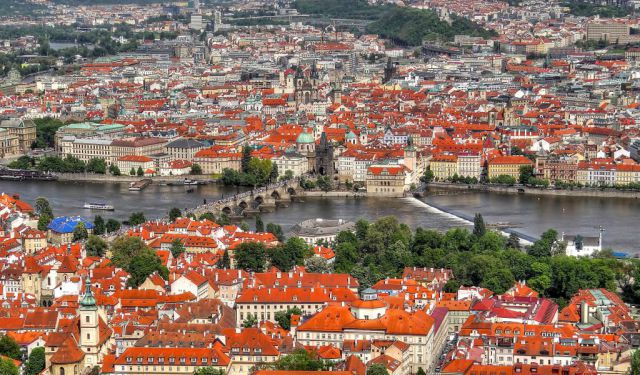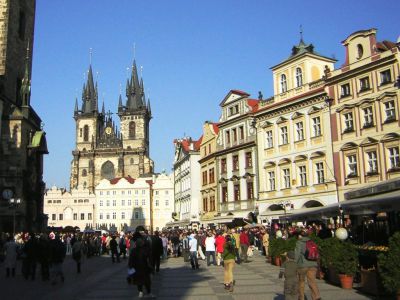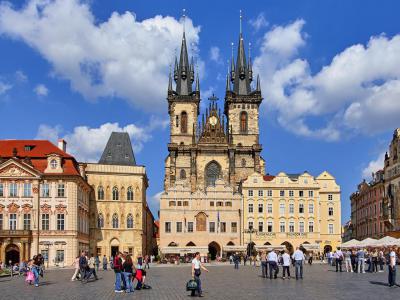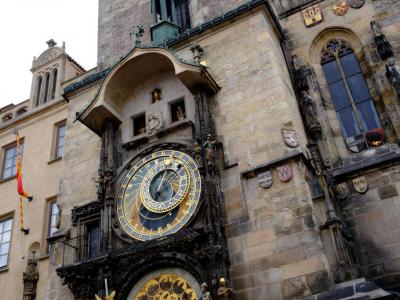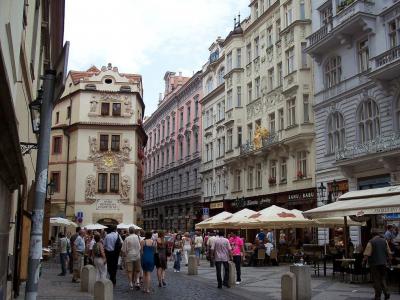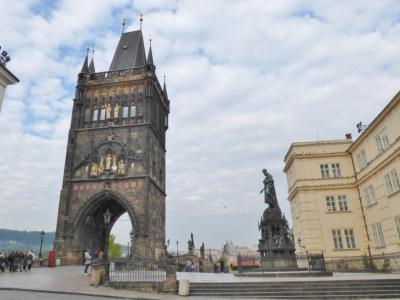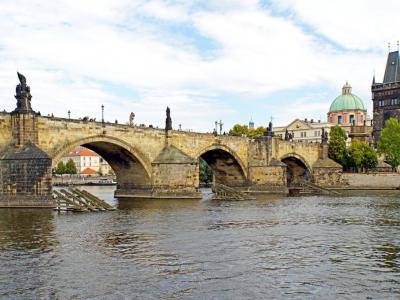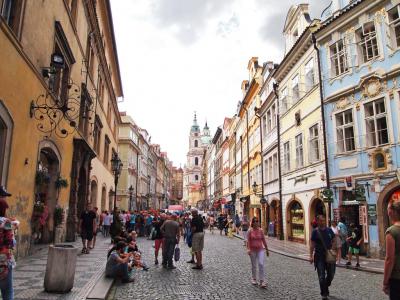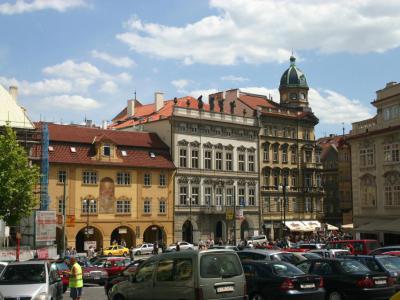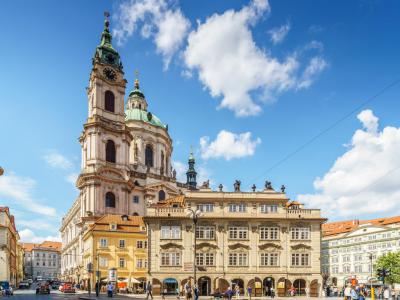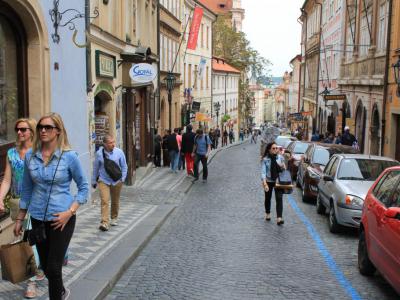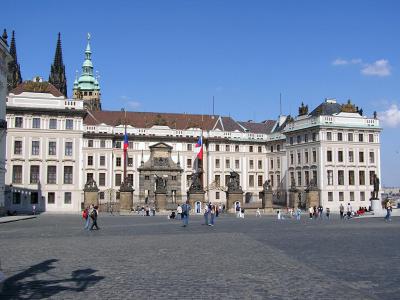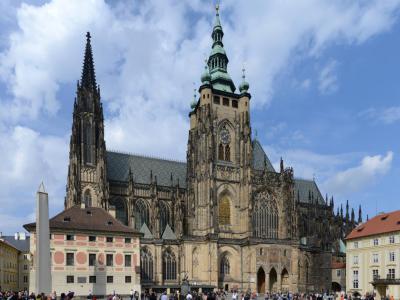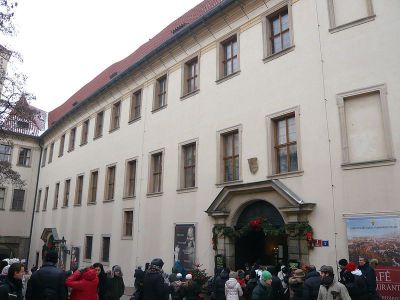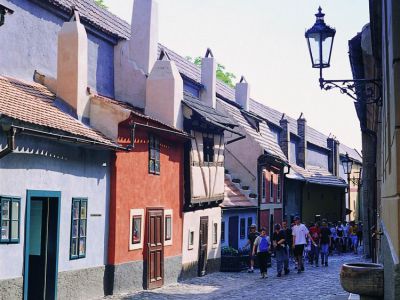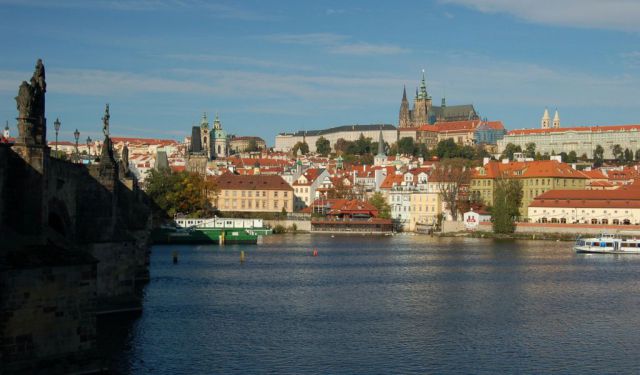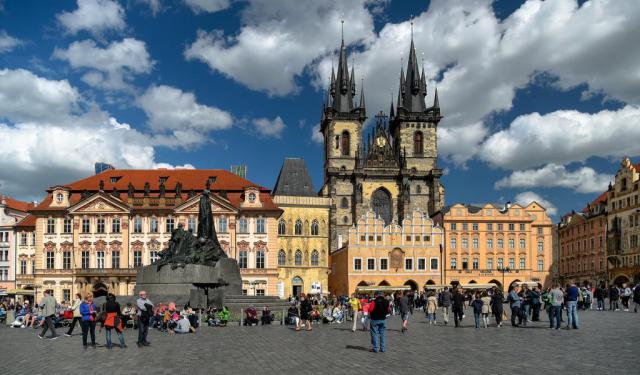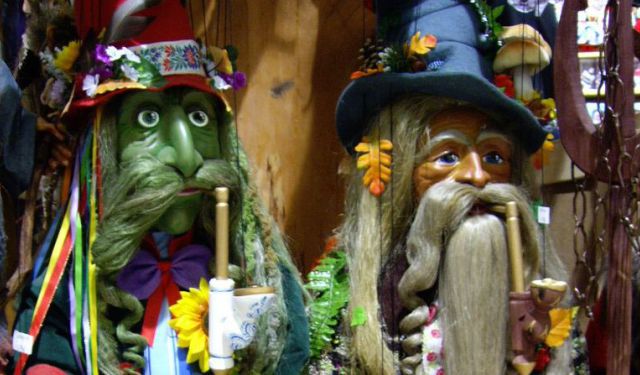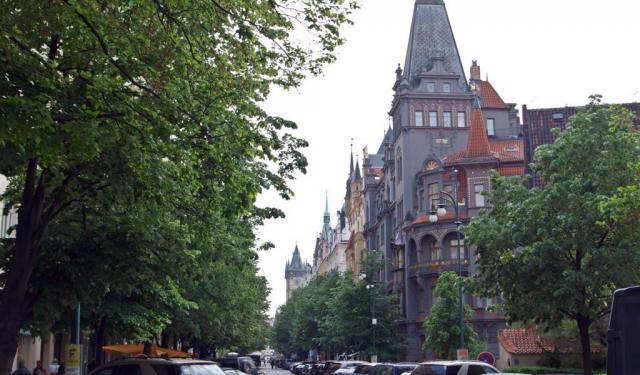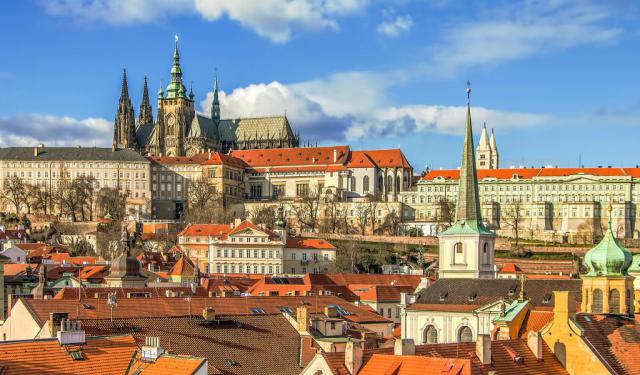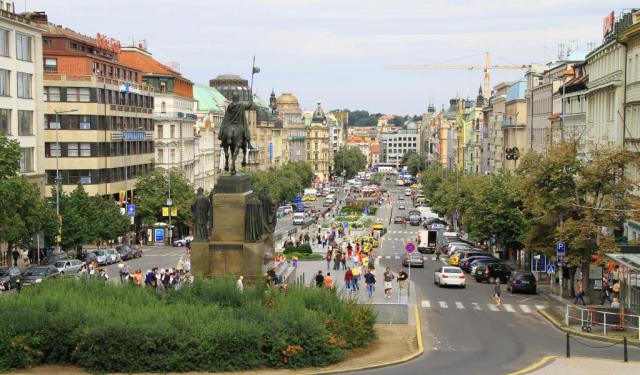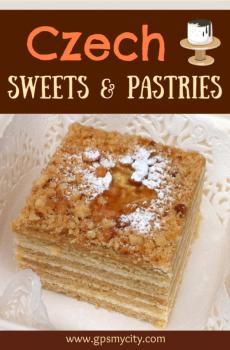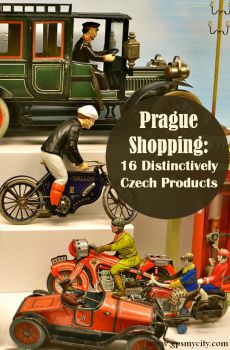Audio Guide: Prague Introduction Walking Tour (Self Guided), Prague
Nicknamed the “City of a Hundred Spires,” Prague is a living gallery of history and architecture, home to world-class museums, eclectic galleries, numerous theaters, and a seemingly endless collection of historic landmarks.
The name Praha comes from the old Slavic word “práh”, which means “rapid”, nodding to the city's beginnings at a crossing on the Vltava River. Legend credits the city’s founding to the 8th-century duchess and seer Libuše, who stood on a cliff above the river and foresaw a great city whose fame would “touch the stars.” She ordered a castle and town to rise from that very spot.
Prague reached its cultural peak under Charles IV, Holy Roman Emperor from 1346 to 1378, becoming the capital of the Kingdom of Bohemia. Later, under Emperor Rudolf II-an eccentric ruler and patron of the arts-the city attracted some of Europe’s brightest minds: astronomers Tycho Brahe and Johannes Kepler, the mystical John Dee and Edward Kelley, painter Giuseppe Arcimboldo, and poet Elizabeth Jane Weston among them.
The city has also stood at the crossroads of pivotal events: the Bohemian Reformation, the Thirty Years’ War, and the sweeping transformations of the Austro-Hungarian Empire. In the 20th century, Prague bore witness to two world wars, decades of communism, and the peaceful Velvet Revolution. Since 1993, it has served as the capital of the newly-emerged Czech Republic.
Remarkably, much of the city’s historic core escaped the devastation that reshaped so much of Europe in the last century. Highlights include Prague Castle, the Charles Bridge, Old Town Square with its fairytale facades, Gothic churches, and the Astronomical Clock’s whimsical procession that plays out every hour.
Now a UNESCO World Heritage Site, the heart of Prague invites you to wander, listen, and look up often. Take your time tracing its cobbled streets, pausing in hidden courtyards, and letting the layers of history unfold around you. Prague isn’t just a destination-it’s an experience waiting to be unraveled at your own pace.
The name Praha comes from the old Slavic word “práh”, which means “rapid”, nodding to the city's beginnings at a crossing on the Vltava River. Legend credits the city’s founding to the 8th-century duchess and seer Libuše, who stood on a cliff above the river and foresaw a great city whose fame would “touch the stars.” She ordered a castle and town to rise from that very spot.
Prague reached its cultural peak under Charles IV, Holy Roman Emperor from 1346 to 1378, becoming the capital of the Kingdom of Bohemia. Later, under Emperor Rudolf II-an eccentric ruler and patron of the arts-the city attracted some of Europe’s brightest minds: astronomers Tycho Brahe and Johannes Kepler, the mystical John Dee and Edward Kelley, painter Giuseppe Arcimboldo, and poet Elizabeth Jane Weston among them.
The city has also stood at the crossroads of pivotal events: the Bohemian Reformation, the Thirty Years’ War, and the sweeping transformations of the Austro-Hungarian Empire. In the 20th century, Prague bore witness to two world wars, decades of communism, and the peaceful Velvet Revolution. Since 1993, it has served as the capital of the newly-emerged Czech Republic.
Remarkably, much of the city’s historic core escaped the devastation that reshaped so much of Europe in the last century. Highlights include Prague Castle, the Charles Bridge, Old Town Square with its fairytale facades, Gothic churches, and the Astronomical Clock’s whimsical procession that plays out every hour.
Now a UNESCO World Heritage Site, the heart of Prague invites you to wander, listen, and look up often. Take your time tracing its cobbled streets, pausing in hidden courtyards, and letting the layers of history unfold around you. Prague isn’t just a destination-it’s an experience waiting to be unraveled at your own pace.
How it works: Download the app "GPSmyCity: Walks in 1K+ Cities" from Apple App Store or Google Play Store to your mobile phone or tablet. The app turns your mobile device into a personal tour guide and its built-in GPS navigation functions guide you from one tour stop to next. The app works offline, so no data plan is needed when traveling abroad.
Prague Introduction Walking Tour Map
Guide Name: Prague Introduction Walking Tour
Guide Location: Czech Republic » Prague (See other walking tours in Prague)
Guide Type: Self-guided Walking Tour (Sightseeing)
# of Attractions: 14
Tour Duration: 2 Hour(s)
Travel Distance: 3.2 Km or 2 Miles
Author: vickyc
Sight(s) Featured in This Guide:
Guide Location: Czech Republic » Prague (See other walking tours in Prague)
Guide Type: Self-guided Walking Tour (Sightseeing)
# of Attractions: 14
Tour Duration: 2 Hour(s)
Travel Distance: 3.2 Km or 2 Miles
Author: vickyc
Sight(s) Featured in This Guide:
- Old Town Square
- Church of Our Lady before Tyn
- Astronomical Clock
- Karlova Street
- Old Town Bridge Tower
- Charles Bridge
- Bridge Street (Mostecka)
- Lesser Town Square
- Church of St. Nicholas (Lesser Town)
- Nerudova Street
- Prague Castle
- St. Vitus Cathedral
- Lobkowicz Palace
- Golden Lane
1) Old Town Square
When in Prague, chances are you’ll be drawn into the Old Town Square-set right in the city’s historic core. It opens up dramatically from the winding alleys around it, and the sheer scale might catch you off guard. Once a bustling medieval marketplace, it’s now a lively, pedestrian-friendly zone filled with shops, cafés, hotels, and street performers. The kind of place where you can relax with fellow travelers, soak in centuries of history, or get swept up in the city’s nightlife as live musicians vie for your attention.
Some of Prague’s most iconic medieval landmarks gather here. You’ll spot the Old Town City Hall, built in 1364, best known for its intricate Astronomical Clock that still draws a crowd every hour. To the north, the 18th-century Saint Nicholas Church gleams in the sunlight, its white façade now home to classical concerts.
Towering above everything else are the spires of the Týn Church, an unmistakable Gothic presence and one of the city’s most photographed churches. Access is tucked behind the Týn School, itself a beautiful Gothic building with graceful arcades. Just nearby, the Stone Bell House hosts exhibitions of modern and contemporary art, while the neighboring Kinsky Palace-now part of the National Gallery-shows off its delicate Rococo façade.
Look south and you’ll see rows of Baroque and Renaissance townhouses, each marked not by numbers but by colorful names and symbols: At the Golden Unicorn, At the Blue Star, At the Red Fox... a throwback to the days before numbered addresses.
At the heart of the square stands the powerful Jan Hus Memorial, erected 500 years after the religious reformer's execution. Burned at the stake in 1415 for his beliefs, Hus remains a symbol of Czech defiance and conviction, known for his firm position against corruption and the abuse of power within the Catholic Church
Tip: Climb the clock tower-or take the elevator-for a sweeping 360-degree view of Prague’s rooftops and beyond. It’s the kind of panorama that sticks with you.
Some of Prague’s most iconic medieval landmarks gather here. You’ll spot the Old Town City Hall, built in 1364, best known for its intricate Astronomical Clock that still draws a crowd every hour. To the north, the 18th-century Saint Nicholas Church gleams in the sunlight, its white façade now home to classical concerts.
Towering above everything else are the spires of the Týn Church, an unmistakable Gothic presence and one of the city’s most photographed churches. Access is tucked behind the Týn School, itself a beautiful Gothic building with graceful arcades. Just nearby, the Stone Bell House hosts exhibitions of modern and contemporary art, while the neighboring Kinsky Palace-now part of the National Gallery-shows off its delicate Rococo façade.
Look south and you’ll see rows of Baroque and Renaissance townhouses, each marked not by numbers but by colorful names and symbols: At the Golden Unicorn, At the Blue Star, At the Red Fox... a throwback to the days before numbered addresses.
At the heart of the square stands the powerful Jan Hus Memorial, erected 500 years after the religious reformer's execution. Burned at the stake in 1415 for his beliefs, Hus remains a symbol of Czech defiance and conviction, known for his firm position against corruption and the abuse of power within the Catholic Church
Tip: Climb the clock tower-or take the elevator-for a sweeping 360-degree view of Prague’s rooftops and beyond. It’s the kind of panorama that sticks with you.
2) Church of Our Lady before Tyn (must see)
Standing tall over Prague’s Old Town, this mighty 14th-century Gothic marvel commands attention like few others. Marked by its uneven twin spires topped with smaller turrets, it is visible from nearly every angle in the city-a reliable landmark for orientation. Alongside the nearby Jan Hus monument, Týn Church stirs deep national pride and adds to that dreamlike quality often dubbed “Magic Prague”"-no wonder Disney used it as an inspiration for his fairytale castle. After dark, bathed in a warm orange glow, the church looks straight out of a storybook.
For a postcard-worthy view of the exterior, grab a ticket to the Clock Tower across the square and ride the lift to the top. Entry to the church itself is free, though a bit hidden: look for the narrow passage-specifically, the last arch on the left among the row of restaurants when you’re facing the spires from the square.
Inside, the Baroque-era makeover is on full display-ornate gilded woodwork, vivid stained glass, and a forest of soaring altarpieces surround you from every angle. They rise beside columns, frame the sanctuary, and line the walls in dazzling abundance.
Fans of astronomy will want to pay their respects at the marble tomb of Tycho Brahe, royal astronomer to Emperor Rudolf II. His likeness is carved into a wooden relief, surrounded by celestial symbols. And if you’re lucky, you might catch a concert on the grand 17th-century organ-check with Via Musica for tickets. The acoustics alone are worth it.
For a postcard-worthy view of the exterior, grab a ticket to the Clock Tower across the square and ride the lift to the top. Entry to the church itself is free, though a bit hidden: look for the narrow passage-specifically, the last arch on the left among the row of restaurants when you’re facing the spires from the square.
Inside, the Baroque-era makeover is on full display-ornate gilded woodwork, vivid stained glass, and a forest of soaring altarpieces surround you from every angle. They rise beside columns, frame the sanctuary, and line the walls in dazzling abundance.
Fans of astronomy will want to pay their respects at the marble tomb of Tycho Brahe, royal astronomer to Emperor Rudolf II. His likeness is carved into a wooden relief, surrounded by celestial symbols. And if you’re lucky, you might catch a concert on the grand 17th-century organ-check with Via Musica for tickets. The acoustics alone are worth it.
3) Astronomical Clock (must see)
The Astronomical Clock on Prague’s Old Town Square has been drawing curious eyes since the 15th century. Every hour from 9 a.m. to 9 p.m., a theatrical blend of medieval engineering and storytelling never fails to draw a crowd. The clock’s beauty is matched by its complexity, with layers of astronomical and calendar dials showcasing the scientific prowess of its creators.
The main dial presents a symbolic view of Earth and Sky, split between day and night. Surrounding that is a ring showing old Bohemian time, while the astronomical display charts the sun and planets as they orbit the Earth-back when the universe revolved around us, of course. Another circle traces the paths of the sun and moon through the zodiac. A final ring on the edge shows the day, date, and the name of the saint commemorated-a matter of significance in medieval times.
But it’s the show on the hour that captures the most attention. From tiny trapdoors above the clock face, a parade of carved apostles appears, led by Christ, moving steadily past two small windows. Overhead, four figures symbolize medieval threats-Death with an hourglass, Greed clutching gold, Vanity admiring his reflection, and a Turk shaking his head. Below, statues representing Philosophy, Religion, Astronomy, and History observe the scene. As the show concludes, a golden rooster flaps and crows, and the clock strikes the hour to polite applause before the spectators disperse.
Local legend adds an eerie layer: the master clockmaker, Hanus, was blinded to ensure he’d never replicate his work elsewhere. In revenge, he damaged the clock, and no one could repair it for a hundred years. Another tale suggests that if the clock ever stops for too long, the fate of Prague may hang in the balance.
Tip: For a bird’s-eye view, take the elevator-or brave the stairs-to the top of the tower. The view is worth every step.
The main dial presents a symbolic view of Earth and Sky, split between day and night. Surrounding that is a ring showing old Bohemian time, while the astronomical display charts the sun and planets as they orbit the Earth-back when the universe revolved around us, of course. Another circle traces the paths of the sun and moon through the zodiac. A final ring on the edge shows the day, date, and the name of the saint commemorated-a matter of significance in medieval times.
But it’s the show on the hour that captures the most attention. From tiny trapdoors above the clock face, a parade of carved apostles appears, led by Christ, moving steadily past two small windows. Overhead, four figures symbolize medieval threats-Death with an hourglass, Greed clutching gold, Vanity admiring his reflection, and a Turk shaking his head. Below, statues representing Philosophy, Religion, Astronomy, and History observe the scene. As the show concludes, a golden rooster flaps and crows, and the clock strikes the hour to polite applause before the spectators disperse.
Local legend adds an eerie layer: the master clockmaker, Hanus, was blinded to ensure he’d never replicate his work elsewhere. In revenge, he damaged the clock, and no one could repair it for a hundred years. Another tale suggests that if the clock ever stops for too long, the fate of Prague may hang in the balance.
Tip: For a bird’s-eye view, take the elevator-or brave the stairs-to the top of the tower. The view is worth every step.
4) Karlova Street
The lively artery linking Old Town Square to Charles Bridge, Karlova Street is rarely quiet. Day and night, it's a steady stream of visitors weaving between souvenir stalls and shopfronts, trying to stay the course as the narrow path twists toward the river. Once part of the historic Royal Route, Karlova wears its Baroque face proudly-though many buildings still hide older Gothic and Romanesque cellars and vaults beneath the surface.
A walk here feels like leafing through a living storybook. Keep an eye out for the unique house signs-each with a legend of its own. “At the Blue Pike,” once frequented by King Wenceslas IV and his magician Zito, offers a glimpse into Prague’s medieval past. “At the French Crown” was home to famed astronomer Johannes Kepler, while further along, “At the Golden Crown” and “At the White Horse” beckon with their 16th-century Gothic elegance.
If you need a break, step through the peaceful courtyards of the Klementinum just off the street’s north side. To support local talent, pop into MANUFAKTURA at number 26-an excellent spot for high-quality Czech souvenirs, all sourced from regional artisans. Or swing by LOCAL ARTISTS at number 21, where every meticulously crafted item celebrates the timeless beauty of Czech craftsmanship-from handmade ceramics to beer-infused cosmetics.
A walk here feels like leafing through a living storybook. Keep an eye out for the unique house signs-each with a legend of its own. “At the Blue Pike,” once frequented by King Wenceslas IV and his magician Zito, offers a glimpse into Prague’s medieval past. “At the French Crown” was home to famed astronomer Johannes Kepler, while further along, “At the Golden Crown” and “At the White Horse” beckon with their 16th-century Gothic elegance.
If you need a break, step through the peaceful courtyards of the Klementinum just off the street’s north side. To support local talent, pop into MANUFAKTURA at number 26-an excellent spot for high-quality Czech souvenirs, all sourced from regional artisans. Or swing by LOCAL ARTISTS at number 21, where every meticulously crafted item celebrates the timeless beauty of Czech craftsmanship-from handmade ceramics to beer-infused cosmetics.
5) Old Town Bridge Tower
Rising proudly at one end of Charles Bridge, this tower is one of Prague’s finest examples of Gothic architecture. Built in the 14th century, it was designed not just as a fortified gateway, but as a ceremonial arch for Bohemian kings making their coronation journey from the Old Town to Prague Castle. It also stood as a key part of the city’s northern defenses during medieval times.
Just above the main archway, you’ll spot the coat of arms of the Bohemian Kingdom alongside the emblem of King Wenceslas IV, depicted as a kingfisher. Above them, three figures hold court: Charles IV to the right, Wenceslas IV to the left, and Saint Vitus, protector of the land, in the center. Higher still, near the peak, stand Saints Vojtech and Sigismund, patrons of Czech lands.
The eastern and western facades were once richly decorated, but much of that detail was lost in 1648 when Swedish troops attacked Prague at the close of the Thirty Years’ War. A commemorative plaque, added soon after, depicts the city’s citizens fighting off the invaders.
The tower also has a few surprises. Its first floor once served as a debtor’s prison; now it hosts a short film recounting the history of the bridge and tower. For a small fee, you can climb to the top for unrivaled views of Prague Castle over the Vltava River.
Look up inside the arch and you’ll find two Latin palindromes carved into the stone that say: “Marked one, marked one, you deserve it - you touch and you torment me” and “Rome will quickly go to you - love moves in upheaval”. No one’s entirely sure where they came from, but some say they were meant as protective spells against evil forces.
Tip: The stairwell is tight and steep-if your knees are feeling it after the climb, try walking backward for the first two or three flights of stairs on your descent. Works like a charm.
Just above the main archway, you’ll spot the coat of arms of the Bohemian Kingdom alongside the emblem of King Wenceslas IV, depicted as a kingfisher. Above them, three figures hold court: Charles IV to the right, Wenceslas IV to the left, and Saint Vitus, protector of the land, in the center. Higher still, near the peak, stand Saints Vojtech and Sigismund, patrons of Czech lands.
The eastern and western facades were once richly decorated, but much of that detail was lost in 1648 when Swedish troops attacked Prague at the close of the Thirty Years’ War. A commemorative plaque, added soon after, depicts the city’s citizens fighting off the invaders.
The tower also has a few surprises. Its first floor once served as a debtor’s prison; now it hosts a short film recounting the history of the bridge and tower. For a small fee, you can climb to the top for unrivaled views of Prague Castle over the Vltava River.
Look up inside the arch and you’ll find two Latin palindromes carved into the stone that say: “Marked one, marked one, you deserve it - you touch and you torment me” and “Rome will quickly go to you - love moves in upheaval”. No one’s entirely sure where they came from, but some say they were meant as protective spells against evil forces.
Tip: The stairwell is tight and steep-if your knees are feeling it after the climb, try walking backward for the first two or three flights of stairs on your descent. Works like a charm.
6) Charles Bridge (must see)
One of Prague’s most iconic landmarks, the Charles Bridge wasn’t just built; it was timed. Construction began on July 9, 1357, at exactly 5:31 in the morning. The oddly precise timing wasn’t random. Holy Roman Emperor Charles IV was a firm believer in numerology and astrology. That moment created a palindrome-135797531-which, in his mind, would grant the bridge strength and longevity. Whether that worked, or whether the secret ingredient was the rumored mix of eggs, wine, or milk stirred into the foundations, we’ll never know. But over six centuries later, the bridge still stands.
Stretching over the Vltava River, it runs 516 meters long and nearly 10 meters wide, supported by 16 sturdy arches with ice guards to fend off the river’s freeze. Until 1841, this was the only way to cross from Prague’s Old Town to the Castle and the Lesser Town. With the boom in traffic in the 20th century, the bridge eventually closed to vehicles and became pedestrian-only in 1978.
Lining both sides are 30 striking Baroque statues, added from the late 1600s through the early 20th century. They complement the Gothic structure underneath and turn any stroll into a kind of open-air museum. As you head toward Lesser Town, keep an eye out for the bronze crucifix-the oldest statue on the bridge-as well as the dramatic tableau of Saint Francis Xavier converting four royal figures from faraway lands: an Indian, Moor, Chinese, and Tartar. Perhaps the most famous is the eighth statue on the right: Saint John of Nepomuk, thrown into the river for refusing to betray the Queen’s confession. Locals say touching his plaque brings luck-or guarantees you’ll return to Prague one day.
Tip: For a quieter, more magical walk, go at dawn or after sunset-when the statues seem to whisper, and the city hushes just long enough to hear them.
Stretching over the Vltava River, it runs 516 meters long and nearly 10 meters wide, supported by 16 sturdy arches with ice guards to fend off the river’s freeze. Until 1841, this was the only way to cross from Prague’s Old Town to the Castle and the Lesser Town. With the boom in traffic in the 20th century, the bridge eventually closed to vehicles and became pedestrian-only in 1978.
Lining both sides are 30 striking Baroque statues, added from the late 1600s through the early 20th century. They complement the Gothic structure underneath and turn any stroll into a kind of open-air museum. As you head toward Lesser Town, keep an eye out for the bronze crucifix-the oldest statue on the bridge-as well as the dramatic tableau of Saint Francis Xavier converting four royal figures from faraway lands: an Indian, Moor, Chinese, and Tartar. Perhaps the most famous is the eighth statue on the right: Saint John of Nepomuk, thrown into the river for refusing to betray the Queen’s confession. Locals say touching his plaque brings luck-or guarantees you’ll return to Prague one day.
Tip: For a quieter, more magical walk, go at dawn or after sunset-when the statues seem to whisper, and the city hushes just long enough to hear them.
7) Bridge Street (Mostecka)
Passing through the arch beneath the Lesser Town Bridge Towers, you’ll find yourself on Bridge Street-a narrow cobblestone lane that has connected Charles Bridge to the Lesser Town Square for over 750 years. Framed by a mix of Renaissance, Baroque, and Rococo facades dating between the 14th and 18th centuries, the street feels like a vivid time capsule. Some of the buildings still carry their original decorative touches: a chained bear at No. 4, a striking bronze door at No. 17, three goats at No. 18, and even a bust of cellist Zelenka. With all its character and charm, it’s no surprise this was once part of the royal coronation route.
Just beyond the towers, on the right side of the street, look for a house marked by three painted ostriches. Once home to Jan Fux, a feather merchant with a flair for fashion, the Renaissance-style building served as both residence and storefront. In 1606, Fux commissioned the bold ostrich design to advertise his trade in luxurious plumes-ostrich feathers were all the rage for hats, uniforms, horse trappings, fans, and finery of every sort.
As you continue your stroll, pause to admire the Gothic tower hidden in the courtyard of “At the Three Golden Bells,” the intricate ironwork and sculptural details on the “At the Black Eagle” house, and the candy-colored, pink-and-yellow Rococo facade of the Kounic Palace.
Toward street’s lower end, you’ll find a mix of boutique shops, inviting restaurants and bars catering to the stream of passersby. When it’s time for a break, stop in at ROESEL café-a warm, family-run spot inside a historic building. Enjoy their daily specials, try a slice of homemade cake with craft beer, and take a moment to explore the mini-exhibition and the charming courtyard.
Just beyond the towers, on the right side of the street, look for a house marked by three painted ostriches. Once home to Jan Fux, a feather merchant with a flair for fashion, the Renaissance-style building served as both residence and storefront. In 1606, Fux commissioned the bold ostrich design to advertise his trade in luxurious plumes-ostrich feathers were all the rage for hats, uniforms, horse trappings, fans, and finery of every sort.
As you continue your stroll, pause to admire the Gothic tower hidden in the courtyard of “At the Three Golden Bells,” the intricate ironwork and sculptural details on the “At the Black Eagle” house, and the candy-colored, pink-and-yellow Rococo facade of the Kounic Palace.
Toward street’s lower end, you’ll find a mix of boutique shops, inviting restaurants and bars catering to the stream of passersby. When it’s time for a break, stop in at ROESEL café-a warm, family-run spot inside a historic building. Enjoy their daily specials, try a slice of homemade cake with craft beer, and take a moment to explore the mini-exhibition and the charming courtyard.
8) Lesser Town Square
Since the 10th century, this arcaded square has been a center of activity on the left bank of the river-a place where merchants once gathered and locals exchanged more than just goods. These days, the rhythm continues with cafés, restaurants, and shops drawing in visitors, while weekend markets add extra color and energy.
Among the square’s most compelling landmarks is the 14th-century Old Town Hall, once the site where non-Catholic nobles drafted the “Czech Confession” in 1575-a bold call for religious tolerance addressed to the Habsburg emperor, later enshrined into Czech law. Today, that historic building has a new life as a nightclub and bar. But it’s the magnificient 18th-century Saint Nicholas Church that truly steals the show. Built over the remains of a Gothic chapel, its interior dazzles with exquisite statuary and a ceiling fresco that stretches across an astonishing 1,500 square meters.
If you’re sipping coffee at the local Starbucks, you’re actually seated in what used to be the Grömling Palace-a prime example of Prague’s Rococo flair. Across the square at number 18, look for the pistachio-and-vanilla-toned Smiřický Palace, easily recognized by its twin turrets. It was here, in 1618, that Protestant leaders convened before launching what would become the infamous Defenestration of Prague-an act that ignited the Thirty Years' War. Not far from there, the High Baroque Sternberg Palace now houses treasures from the National Gallery.
Commanding a significant portion of the square’s northern side is the Czech Parliament. So don’t be surprised to see suited officials weaving through the crowd-just another reminder that this historic space remains very much alive.
Among the square’s most compelling landmarks is the 14th-century Old Town Hall, once the site where non-Catholic nobles drafted the “Czech Confession” in 1575-a bold call for religious tolerance addressed to the Habsburg emperor, later enshrined into Czech law. Today, that historic building has a new life as a nightclub and bar. But it’s the magnificient 18th-century Saint Nicholas Church that truly steals the show. Built over the remains of a Gothic chapel, its interior dazzles with exquisite statuary and a ceiling fresco that stretches across an astonishing 1,500 square meters.
If you’re sipping coffee at the local Starbucks, you’re actually seated in what used to be the Grömling Palace-a prime example of Prague’s Rococo flair. Across the square at number 18, look for the pistachio-and-vanilla-toned Smiřický Palace, easily recognized by its twin turrets. It was here, in 1618, that Protestant leaders convened before launching what would become the infamous Defenestration of Prague-an act that ignited the Thirty Years' War. Not far from there, the High Baroque Sternberg Palace now houses treasures from the National Gallery.
Commanding a significant portion of the square’s northern side is the Czech Parliament. So don’t be surprised to see suited officials weaving through the crowd-just another reminder that this historic space remains very much alive.
9) Church of St. Nicholas (Lesser Town) (must see)
Towering over Lesser Town is a Baroque masterpiece-one of the most recognizable landmarks along Prague’s left bank. With its colossal green dome and soaring tower, this church was the grandest project of the Jesuits in Bohemia, a bold statement of their significant influence over the region in the 18th century. The contrast between the dome’s solid breadth and the tower’s slender elegance adds a distinctive flair to the city’s silhouette.
Step inside, and you’re met with a riot of pinks and greens that almost overwhelm the senses. The space is alive with movement-from the dynamic statues and vibrant frescoes to the polished, faux-marble columns. At the center, a sweeping ceiling painting brings to life the miracles of Saint Nicholas in true Baroque drama. But it’s the towering dome that steals the spotlight. Look up, and you’ll find four stern-faced Church Fathers circling the space-one of them even clutching a golden thunderbolt as if daring you to question the weight of their message.
The organ alone is worth the visit. Installed in the 1740s and fitted with more than 4,000 pipes, it once echoed with the music of Mozart himself, who played here during his time in Prague. After his death, this is where his Requiem was performed. With such acoustics, it's no wonder the church still hosts classical concerts to this day.
During the communist era, the bell tower wasn’t just a place of worship-it also served as a surveillance outpost for State Security, keeping a close eye on the embassies below. Now, you can climb the 299 steps to the gallery, perched 65 meters above the square, and enjoy a fine perspective over Lesser Town and the Charles Bridge beyond.
Step inside, and you’re met with a riot of pinks and greens that almost overwhelm the senses. The space is alive with movement-from the dynamic statues and vibrant frescoes to the polished, faux-marble columns. At the center, a sweeping ceiling painting brings to life the miracles of Saint Nicholas in true Baroque drama. But it’s the towering dome that steals the spotlight. Look up, and you’ll find four stern-faced Church Fathers circling the space-one of them even clutching a golden thunderbolt as if daring you to question the weight of their message.
The organ alone is worth the visit. Installed in the 1740s and fitted with more than 4,000 pipes, it once echoed with the music of Mozart himself, who played here during his time in Prague. After his death, this is where his Requiem was performed. With such acoustics, it's no wonder the church still hosts classical concerts to this day.
During the communist era, the bell tower wasn’t just a place of worship-it also served as a surveillance outpost for State Security, keeping a close eye on the embassies below. Now, you can climb the 299 steps to the gallery, perched 65 meters above the square, and enjoy a fine perspective over Lesser Town and the Charles Bridge beyond.
10) Nerudova Street
Tucked into the Lesser Town area, Nerudova Street offers more than just a picturesque uphill stroll-it’s a step back into Prague’s past, especially if you’ve got an eye for quirky details. Once the final leg of ceremonial route used for coronation processions, the street more recently earned its name from Czech writer Jan Neruda, who drew rich inspiration from the neighborhood's characters and corners.
Before Prague adopted house numbers in the 18th century, buildings were identified by unique pictorial signs-and Nerudova is a goldmine of them. Look for No. 12, “At the Three Fiddles,” once home to a family of violin makers. Or “At the Golden Cup,” marked with the emblem of goldsmiths, dating back to 1660. At No. 34, a painted horse still stands over a real horseshoe mounted on the wall, placed there in 1559.
Architecture buffs should pause at Morzin Palace, No. 5, designed by Giovanni Santini and with an allegorical “Night and Day” façade by Ferdinand Brokoff, the same artist behind many of Charles Bridge’s iconic figures. Directly across, at No. 20, Thun-Hohenstein Palace has a gateway flanked by eagles, created by another Charles Bridge sculptor-Mathias Braun. Keep an eye out for No. 13’s passage archway, a classic Lesser Town detail, and No. 33, the Bretfeld Palace, where Mozart and Casanova stayed during the 1787 premiere of “Don Giovanni”.
For lighter diversions, swing by the Gingerbread Museum at No. 9 or pop into Czech Marionettes at No. 51, where carved linden puppets range from classic characters to eerily reptilian wizards and princesses in pink-plus a few modern politicians!
Before Prague adopted house numbers in the 18th century, buildings were identified by unique pictorial signs-and Nerudova is a goldmine of them. Look for No. 12, “At the Three Fiddles,” once home to a family of violin makers. Or “At the Golden Cup,” marked with the emblem of goldsmiths, dating back to 1660. At No. 34, a painted horse still stands over a real horseshoe mounted on the wall, placed there in 1559.
Architecture buffs should pause at Morzin Palace, No. 5, designed by Giovanni Santini and with an allegorical “Night and Day” façade by Ferdinand Brokoff, the same artist behind many of Charles Bridge’s iconic figures. Directly across, at No. 20, Thun-Hohenstein Palace has a gateway flanked by eagles, created by another Charles Bridge sculptor-Mathias Braun. Keep an eye out for No. 13’s passage archway, a classic Lesser Town detail, and No. 33, the Bretfeld Palace, where Mozart and Casanova stayed during the 1787 premiere of “Don Giovanni”.
For lighter diversions, swing by the Gingerbread Museum at No. 9 or pop into Czech Marionettes at No. 51, where carved linden puppets range from classic characters to eerily reptilian wizards and princesses in pink-plus a few modern politicians!
11) Prague Castle (must see)
When you hear “Prague Castle,” you might picture one grandiose palace with spires and regal chambers-but in reality, it’s even more than that. What you're looking at is a vast, fortified complex filled with government buildings, centuries-old churches, art-filled museums, stunning gardens, and the famously charming Golden Lane-where Franz Kafka once lived in a tiny cottage. Covering over 17 acres, or 70,000 square meters, it holds the Guinness World Record as the largest castle complex in existence, and its roots stretch all the way back to the 9th century.
This place has seen centuries of rulers come and go-from medieval kings and Habsburg monarchs to Tomáš Masaryk, the first president of Czechoslovakia. Today, it’s still the official residence of the Czech president, and you can tell when they’re in town by the national flag flying above the entrance. Just outside the main gates, the stoic castle guards carry out the ceremonial changing of the guard every day at noon, with smaller routines each hour starting at 7 a.m.
The architecture here is a timeline in stone-Saint Vitus Cathedral blends Gothic drama with Renaissance and Baroque flourishes, while nearby Saint George’s Basilica keeps things somewhat simpler with a Romanesque interior hidden behind a Baroque facade. You’ll even notice touches from the 20th century scattered across the grounds, making the Castle feel like a living archive of Czech history.
If you’re planning to explore the whole complex, set aside at least 3 to 5 hours-it’s worth taking your time. The castle gardens are open to the public for free, perfect for wandering or simply sitting and soaking up the atmosphere. If the ticket line at the main entrance seems long, try one of the booths deeper in the courtyard-they’re often quicker and easier to access.
This place has seen centuries of rulers come and go-from medieval kings and Habsburg monarchs to Tomáš Masaryk, the first president of Czechoslovakia. Today, it’s still the official residence of the Czech president, and you can tell when they’re in town by the national flag flying above the entrance. Just outside the main gates, the stoic castle guards carry out the ceremonial changing of the guard every day at noon, with smaller routines each hour starting at 7 a.m.
The architecture here is a timeline in stone-Saint Vitus Cathedral blends Gothic drama with Renaissance and Baroque flourishes, while nearby Saint George’s Basilica keeps things somewhat simpler with a Romanesque interior hidden behind a Baroque facade. You’ll even notice touches from the 20th century scattered across the grounds, making the Castle feel like a living archive of Czech history.
If you’re planning to explore the whole complex, set aside at least 3 to 5 hours-it’s worth taking your time. The castle gardens are open to the public for free, perfect for wandering or simply sitting and soaking up the atmosphere. If the ticket line at the main entrance seems long, try one of the booths deeper in the courtyard-they’re often quicker and easier to access.
12) St. Vitus Cathedral (must see)
Rising above the Vltava River from within the grounds of Prague Castle, Saint Vitus Cathedral is hailed as a pinnacle of Gothic architectire and a powerful emblem of Bohemian identity. For generations, it has been the final resting place of kings and emperors, and its very presence resonates with centuries of history. But even if you're not drawn in by royal lineages or historic timelines, the striking façade, sweeping nave, and exquisite stained glass stir something deeper-a quiet sense of awe and reverence that transcends time.
The first thing you'll likely notice is the imposing Great Tower, topped with a Baroque dome and housing Sigismund-the largest bell in Bohemia, cast in the 1500s and weighing in at over 33,000 pounds. Just beside it is the cathedral’s southern entrance-the Golden Gate-famed for its gleaming mosaic of the Last Judgment, crafted from Venetian glass.
Inside, you’re instantly struck by the vertical grandeur of the nave. On the left, the stained-glass windows impart a transcendent aura; particularly the third one-a vivid Art Nouveau piece by Alfons Mucha, which tells the story of Christianity in the Czech lands through a kaleidoscope of color and symbolism. Other highlights include a wooden panorama of old Prague, the extravagant silver tomb of Saint John of Nepomuk, and a fascinating mix of sculptural details that range from sacred to surreal.
A few tips before your visit: entry to the main area and some interior sections is free, but a full tour requires a ticket bundled with Prague Castle access. There’s also an option to climb the tower-for a separate fee-rewarding the ambitious with sweeping views, assuming you're up for the tight staircase.
The first thing you'll likely notice is the imposing Great Tower, topped with a Baroque dome and housing Sigismund-the largest bell in Bohemia, cast in the 1500s and weighing in at over 33,000 pounds. Just beside it is the cathedral’s southern entrance-the Golden Gate-famed for its gleaming mosaic of the Last Judgment, crafted from Venetian glass.
Inside, you’re instantly struck by the vertical grandeur of the nave. On the left, the stained-glass windows impart a transcendent aura; particularly the third one-a vivid Art Nouveau piece by Alfons Mucha, which tells the story of Christianity in the Czech lands through a kaleidoscope of color and symbolism. Other highlights include a wooden panorama of old Prague, the extravagant silver tomb of Saint John of Nepomuk, and a fascinating mix of sculptural details that range from sacred to surreal.
A few tips before your visit: entry to the main area and some interior sections is free, but a full tour requires a ticket bundled with Prague Castle access. There’s also an option to climb the tower-for a separate fee-rewarding the ambitious with sweeping views, assuming you're up for the tight staircase.
13) Lobkowicz Palace
Tucked inside the sprawling grounds of Prague Castle, there's one building that doesn’t belong to the state-and almost never did. This 16th-century palace, still in the hands of the Lobkowicz family, made its way back into aristocratic ownership after the fall of communism. These days, it's not just a relic of the past, but very much alive with purpose. Part museum, part event venue, part midday concert escape, it's got culture and character to spare. And yes, the terrace view here is a full 180 degrees of cityscape-best enjoyed with the 30-minute “Prague Inspires Panorama Tour” offered with each audio guide.
The guide is voiced by the Lobkowicz family themselves, walking you through centuries of history and art. Expect an all-star lineup, including Canaletto, Brueghel the Elder, and Velázquez. There’s also a treasure trove of arms, armor, and ceramics-including the world’s largest surviving Delft dinner service. And for music lovers-original manuscripts by Beethoven, Mozart, and Haydn are on display, including pieces Beethoven composed specifically for the Lobkowicz family.
The palace’s reception halls, balconies, and the concert space are all decked out with lavish mythological frescoes, while the Imperial Hall tricks the eye with Roman statues that aren’t statues at all. Otherwise, don’t miss the 17th-century chapel dedicated to Saint Wenceslas, where medallions on the walls retell the saga of the Czech Republic’s patron saint.
Tip: Once your museum journey winds down-and your head’s buzzing with beauty and history-swing by the museum shop for a keepsake, then recharge at the café. It caters to all cravings, and rumor has it their burgers might just be the best in town.
The guide is voiced by the Lobkowicz family themselves, walking you through centuries of history and art. Expect an all-star lineup, including Canaletto, Brueghel the Elder, and Velázquez. There’s also a treasure trove of arms, armor, and ceramics-including the world’s largest surviving Delft dinner service. And for music lovers-original manuscripts by Beethoven, Mozart, and Haydn are on display, including pieces Beethoven composed specifically for the Lobkowicz family.
The palace’s reception halls, balconies, and the concert space are all decked out with lavish mythological frescoes, while the Imperial Hall tricks the eye with Roman statues that aren’t statues at all. Otherwise, don’t miss the 17th-century chapel dedicated to Saint Wenceslas, where medallions on the walls retell the saga of the Czech Republic’s patron saint.
Tip: Once your museum journey winds down-and your head’s buzzing with beauty and history-swing by the museum shop for a keepsake, then recharge at the café. It caters to all cravings, and rumor has it their burgers might just be the best in town.
14) Golden Lane
One of the most fascinating corners within Prague Castle, Golden Lane is a narrow street lined with brightly colored, pint-sized cottages that feel plucked from a fairy tale. Walking along the cobblestones, past vivid facades and tiny windows, you’re stepping into the last surviving example of the Castle’s more humble, small-scale architecture.
The lane dates back to the 16th century, originally built to house castle guards. It later took its name from the goldsmiths who moved in a hundred years later. By the 1800s, it had evolved into a sort of artistic enclave, drawing in poets and craftsmen. Franz Kafka spent time here in 1916, writing in a small cottage during long winter evenings, and Jaroslav Seifert, a future Nobel Prize laureate, also called the lane home.
Although people lived in these tiny houses up until World War II, they’ve since been carefully restored, keeping their original charm intact. Inside, you’ll find exhibits of medieval armor and weapons, alongside displays of period textiles-and yes, a few cozy souvenir shops and snack bars. The lane ends at Daliborka Tower, once a prison, where you can view historical torture devices-a darker but compelling window into the past.
Tip: If you have a castle ticket, entry is included. But if you’re looking to stroll through just for the atmosphere, come after 5 p.m. when the path is freely open-though most interiors will be closed by then.
The lane dates back to the 16th century, originally built to house castle guards. It later took its name from the goldsmiths who moved in a hundred years later. By the 1800s, it had evolved into a sort of artistic enclave, drawing in poets and craftsmen. Franz Kafka spent time here in 1916, writing in a small cottage during long winter evenings, and Jaroslav Seifert, a future Nobel Prize laureate, also called the lane home.
Although people lived in these tiny houses up until World War II, they’ve since been carefully restored, keeping their original charm intact. Inside, you’ll find exhibits of medieval armor and weapons, alongside displays of period textiles-and yes, a few cozy souvenir shops and snack bars. The lane ends at Daliborka Tower, once a prison, where you can view historical torture devices-a darker but compelling window into the past.
Tip: If you have a castle ticket, entry is included. But if you’re looking to stroll through just for the atmosphere, come after 5 p.m. when the path is freely open-though most interiors will be closed by then.
Walking Tours in Prague, Czech Republic
Create Your Own Walk in Prague
Creating your own self-guided walk in Prague is easy and fun. Choose the city attractions that you want to see and a walk route map will be created just for you. You can even set your hotel as the start point of the walk.
Lesser Town Walking Tour
Malá Strana, or the “Lesser Town,” lies along the left bank of the Vltava River and remains one of Prague’s most charming and historically layered districts. In medieval times, it was primarily settled by ethnic Germans, and even as Baroque architecture reshaped the neighborhood following the devastating fire of 1541, the area held onto its Germanic roots for generations. Its location near... view more
Tour Duration: 2 Hour(s)
Travel Distance: 3.9 Km or 2.4 Miles
Tour Duration: 2 Hour(s)
Travel Distance: 3.9 Km or 2.4 Miles
Old Town Walking Tour
Prague’s Old Town is a living tapestry of medieval roots and vibrant modern life, wrapped in narrow cobblestone streets and brimming with architectural treasures. Once a self-contained settlement, it was protected by a semi-circular moat and a fortified wall, both tracing the curve of the Vltava River. Although the moat is long gone, its path survives in the form of key streets-most notably Na... view more
Tour Duration: 2 Hour(s)
Travel Distance: 2.8 Km or 1.7 Miles
Tour Duration: 2 Hour(s)
Travel Distance: 2.8 Km or 1.7 Miles
Old Town Souvenir Shopping
Strolling through the Old Town of Prague, souvenir shopping becomes a delightful adventure. Indeed, it would be a pity to leave Prague without having explored its specialty shops and bringing home something truly original and unique to the city.
One of the prime spots for such endeavors is the Municipal House, a majestic Art Nouveau building that houses various shops and boutiques. Here,... view more
Tour Duration: 1 Hour(s)
Travel Distance: 1.7 Km or 1.1 Miles
One of the prime spots for such endeavors is the Municipal House, a majestic Art Nouveau building that houses various shops and boutiques. Here,... view more
Tour Duration: 1 Hour(s)
Travel Distance: 1.7 Km or 1.1 Miles
Jewish Quarter Walking Tour
The Jewish Quarter of Prague carries over a thousand years of memory etched into its streets, synagogues, and gravestones. Jewish communities began settling in this area as early as the 10th century, and although they were later forced into a walled ghetto, they cultivated a vibrant cultural and intellectual life-especially during the 16th century, a golden age shaped by the influence of Rabbi Ben... view more
Tour Duration: 1 Hour(s)
Travel Distance: 1.1 Km or 0.7 Miles
Tour Duration: 1 Hour(s)
Travel Distance: 1.1 Km or 0.7 Miles
Hradcany (Castle District) Walking Tour
Prague’s Castle District is a neighborhood where history feels almost tangible-an atmospheric blend of towering landmarks, quiet courtyards, and sweeping city views. At its heart sits the mighty Prague Castle, often cited as the largest castle complex in the world. Its origins stretch back to the 9th century, and over time, it has been home to Bohemian kings, Holy Roman emperors, Communist... view more
Tour Duration: 2 Hour(s)
Travel Distance: 3.0 Km or 1.9 Miles
Tour Duration: 2 Hour(s)
Travel Distance: 3.0 Km or 1.9 Miles
New Town Walking Tour
The youngest (founded in 1348) and the largest (three times the size of the Old Town), the New Town (or Nove Mesto) of Prague is one of the five originally independent townships that today form the historic center of the Czech capital. This vibrant district offers a mix of historical charm and modern amenities and is traditionally dense with tourists.
At its heart lies Wenceslas Square, a... view more
Tour Duration: 2 Hour(s)
Travel Distance: 3.1 Km or 1.9 Miles
At its heart lies Wenceslas Square, a... view more
Tour Duration: 2 Hour(s)
Travel Distance: 3.1 Km or 1.9 Miles
Useful Travel Guides for Planning Your Trip
Czech Sweets and Pastries
Once part of the Austro-Hungarian Empire, the Czechs have duly absorbed the dessert-making know-how of their Austrian neighbors to complement their own confectionery heritage deeply rooted in the Eastern European, Slavic tradition. The end result of such cultural blend is the abundance of pastries,...
Prague Shopping: 15 Distinctively Czech Products to Bring Home
Previously known mainly for its beer and ice-hockey (both for a very good reason), today's Czech Republic - and, primarily, its capital city Prague - is seen among the top European tourist destinations emerged following the breakup of the Soviet Bloc. A shooting ground for some Hollywood...
The Most Popular Cities
/ view all
